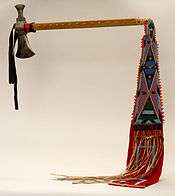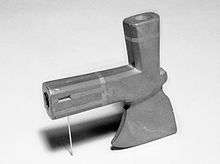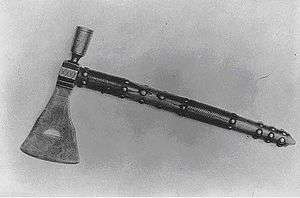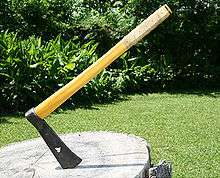Tomahawk (axe)

A tomahawk (also referred to as a hawk) is a type of single-handed axe from North America, traditionally resembling a hatchet with a straight shaft.[1][2] The name came into the English language in the 17th century as an adaptation of the Powhatan (Virginian Algonquian) word.
Tomahawks were general purpose tools used by Native Americans and European colonials alike, and often employed as a hand-to-hand or a thrown weapon. The metal tomahawk heads were originally based on a Royal Navy boarding axe and used as a trade-item with Native Americans for food and other provisions.[1][2]
Etymology
The name comes from Powhatan tamahaac, derived from the Proto-Algonquian root *temah- 'to cut off by tool'.[3] Algonquian cognates include Lenape təmahikan,[4] Malecite-Passamaquoddy tomhikon, Abenaki demahigan, all of which mean 'axe'.[5][6]
History


The Algonquian Indians in Native America created the tomahawk. Before Europeans came to America, Native Americans would use stones attached to wooden handles, secured with strips of rawhide. Though typically used as weapons, they could also be used for everyday tasks, such as chopping, cutting or hunting.
When Europeans arrived in North America, they introduced the metal blade to the natives, which improved the effectiveness of the tool. Metal did not break as readily as stone and could be fashioned for additional uses. Native Americans created a tomahawk’s poll, the side opposite the blade, which consisted of a hammer, spike or a pipe. These became known as pipe tomahawks, which consisted of a bowl on the poll and a hollowed out shaft. These were created by European and American artisans for trade and diplomatic gifts for the tribes.[7]
Composition

Pre-contact Native Americans lacked ironmaking technology, so tomahawks were not fitted with metal axe heads until they could be obtained from trade with Europeans. The tomahawk's original designs were fitted with heads of bladed or rounded stone or deer antler.[3][8]

The modern tomahawk shaft is usually less than 2 ft (61 cm) in length, traditionally made of hickory, ash, or maple.[1][2][9] The heads weigh anywhere from 9–20 oz (260–570 g), with a cutting edge usually not much longer than four inches (10 cm) from toe to heel.[2] The poll can feature a hammer, spike, or may simply be rounded off, and they usually do not have lugs.[1][2] These sometimes had a pipe-bowl carved into the poll, and a hole drilled down the center of the shaft for smoking tobacco through the tomahawk.[2] There are also metal-headed versions of this unusual pipe.[2] Pipe tomahawks are artifacts unique to North America: created by Europeans as trade objects but often exchanged as diplomatic gifts.[1] They were symbols of the choice Europeans and Native Americans faced whenever they met: one end was the pipe of peace, the other an axe of war.[1][2][9]
In colonial French territory, a very different tomahawk design, closer to the ancient European francisca, was in use by French settlers and indigenous peoples.[9] In the late 18th century, the British Army issued tomahawks to their colonial regulars during the American Revolutionary War as a weapon and tool.[10]
Modern use
Tomahawk throwing[11] is a popular sport among American historical re-enactment groups, and new martial arts such as Okichitaw have begun to revive tomahawk fighting techniques used during the colonial era.[12] Tomahawks are a category within competitive knife throwing. Today's hand-forged tomahawks are being made by master craftsmen throughout the United States.[13][14]

Modern tomahawks designed by Peter LaGana included wood handles, a hatchet-like bit and a leather sheath and were used by select US forces during the Vietnam War and are referred to as "Vietnam tomahawks".[13][15] These modern tomahawks have gained popularity with their re-emergence by American Tomahawk Company in the beginning of 2001 and a collaboration with custom knife-maker Ernest Emerson of Emerson Knives, Inc.[13] A similar wood handle Vietnam tomahawk is produced today by Cold Steel. The tomahawk was later redesigned featuring synthetic shafts by American Tomahawk Company and named "VTAC" ("Vietnam Tactical Tomahawk") and are manufactured by Fehrman Knives. SOG Knives Inc. has also entered the field with its own version of the Vietnam tomahawk, the Fusion Tactical Tomahawk. Original Vietnam tomahawks are rare and expensive.[13]
Tomahawks are useful in camping and bushcraft scenarios. They are mostly used as an alternative to a hatchet, as they are generally lighter and slimmer than hatchets. They often contain other tools in addition to the axe head, such as spikes or hammers.[16]
Many of these modern tomahawks are made of drop forged, differentially heat treated, alloy steel.[17] The differential heat treatment allows for the chopping portion and the spike to be harder than the middle section, allowing for a shock-resistant body with a durable temper.[17]
Tomahawk throwing competitions
Today, there are hundreds of rendezvous and events that host tomahawk throwing competitions.[18] These events typically require mountain man style dress.[16]
The tomahawk competitions themselves have their own regulations concerning the type and style of tomahawk used for throwing. There are special throwing tomahawks made for these kinds of competitions. Requirements such as a minimum handle length and a maximum blade edge (usually 4") are the most common tomahawk throwing competition rules.[18]
One such tomahawk throwing competition is made and sponsored by the International Knife Throwers Hall of Fame. They have a ranking system to determine skill level. The International Knife Throwers Hall of Fame Association ranking system establishes an international standard by which knife and hawk throwers may measure their accuracy and versatility, and compare their skill to that of any knife and hawk thrower anywhere in the world.[18]
Military application
American Tomahawk Company's VTAC was used by the US Army Stryker Brigade in Afghanistan, the 172nd Stryker Brigade Combat Team based at Grafenwöhr (Germany), the 3rd Brigade, 2nd Infantry Division out of Fort Lewis, a reconnaissance platoon in the 2d Squadron 183d Cavalry (116th Infantry Brigade Combat Team) (OIF 2007–2008) and numerous other soldiers.[13][17] The VTAC was issued a national stock number (4210-01-518-7244) and classified as a “Class 9 rescue kit” as a result of a program called the Rapid Fielding Initiative; it is also included within every Stryker vehicle as the “modular entry tool set”.[13][17] This design enjoyed something of a renaissance with US soldiers in Iraq and Afghanistan as a tool and in use in hand-to-hand combat.[19]
Law enforcement
The tomahawk has gained some respect by members of various law enforcement tactical (i.e. "SWAT") teams. Some companies have seized upon this new popularity and are producing "tactical tomahawks." These SWAT-oriented tools are designed to be both useful and relatively light. Some examples of "tactical tomahawks" include models wherein the shaft is designed as a prybar. There are models with line/rope cutting notches, cuts in the head allowing its use as a wrench, and models with broad, heavy heads to assist in breaching doors.[20]
Modern tomahawk fighting
There are not many systems worldwide which teach fighting skills with the axe or a tomahawk to civilians however one martial art known as Okichitaw teaches Tomahawk fighting in conjunction with other Indigenous weapons such as the Plains Dagger, Lance and Gunstock War Club mostly based on Plains Indian Combat principles. Since the axe is becoming more popular again in movies and video games (e.g.: The Patriot; Abraham Lincoln: Vampire Hunter; Bullet to the Head; Assassin's Creed III) the interest in tomahawk and axe training within the martial arts has grown. It can also be observed however that Escrima practitioners are putting it to use.[21]
Manufacturers
Modern tomahawk manufacturers include:
- American Tomahawk Company
- Benchmade Knife Company
- Gerber Legendary Blades
- Cold Steel
- Winkler Knives
- RMJ Tactical
See also
References
- 1 2 3 4 5 6 Haskew, Mike (2003-09-01). "Pipe Hawks". 30 (9). Blade Magazine. pp. 26–34.
- 1 2 3 4 5 6 7 8 Haskew, Mike (2006-09-01). "Star-Spangled Hawks Take Wing". 33 (9). Blade Magazine. pp. 30–37.
- 1 2 Cutler, Charles L. (2002). Tracks that Speak: The Legacy of Native American Words in North American Culture. Boston: Houghton Mifflin Harcourt. p. 139. ISBN 0-618-06509-1. Retrieved 2012-10-27.
- ↑ "tëmahikàn". Lenape Talking Dictionary. Retrieved 2012-10-27. The Lenape root təmə- means 'to cut off' and the suffix -hikan forms the names of tools.
- ↑ Hranicky, William (1 April 2009). Material Culture from Prehistoric Virginia. AuthorHouse. p. 56. ISBN 978-1-4389-6661-8.
- ↑ Jahr, Ernst Håkon; Broch, Ingvild (1996). Language Contact in the Arctic: Northern Pidgins and Contact Languages. Walter de Gruyter. p. 295. ISBN 978-3-11-014335-5.
- ↑ "Tomahawk History". Hawkthrowing.com. Retrieved 22 July 2014.
- ↑ Taylor, Colin F. (2001). Native American Weapons. Norman, Okla.: University of Oklahoma Press. p. 30. ISBN 0806133465. Retrieved 2012-11-17.
The wooden ballheaded club at this time was also generally referred to as a "tomahawk"
- 1 2 3 Haskew, Mike (2004-09-01). "Legends and Lore Through the Spike Tomahawk". 28 (9). Blade Magazine. pp. 12–19.
- ↑ Dick, Steven (2002-05-01). "Frontier Hatchets still On Duty". 10 (5). Tactical Knives. pp. 43–47.
- ↑ "How to Throw a Tomahawk", HatchetsandAxes.com, February 23, 2011, accessed May 3, 2011.
- ↑ Joan Taillon (1 September 2004). "Toronto martial arts group visits North Korea". The Aboriginal Newspaper of Ontario. Retrieved 2008-07-20.
- 1 2 3 4 5 6 Steele, David E."Wedged Edges at War",Blade Magazine, September 2005, page 12-19
- ↑ "Tomahawk Makes Front Page News in San Francisco" (PDF). "Mountaineer-Herald. 25 January 1968. p. 8. Retrieved 2008-07-14.
- ↑ "Marines Stuck On Tomahawk" (PDF). The Pittsburgh Press. 25 February 1968. p. 2. Retrieved 2008-07-14.
- 1 2 Fadala, Sam (2006). The Complete Blackpowder Handbook. Iola, Wisconsin: Gun Digest Books. p. 348. ISBN 0-89689-390-1.
- 1 2 3 4 Emerson, Ernest (2007). "The Modern Tomahawk". American Handgunner: 15.
- 1 2 3 "How to Organize a Tomahawk Throwing Competition". HatchetsandAxes.com. March 30, 2012.
- ↑ Tillett, David (2003-04-15). "Lethal Weapon:Historic Tomahawk Returns to the Battlefield with Some U.S. Troops". ABC News. Retrieved 2007-01-24.
- ↑ Kaplan, Steven J. (27 December 2010). TAIHO-JUTSU: The Art of Arrests. Xlibris Corporation. p. 216. ISBN 978-1-4653-2508-2.
- ↑ McLemore, Dwight C. (2010). "Boulder, Colorado". The Fighting Tomahawk. Paladin Press. p. 27. ISBN 978-1-58160-729-1.